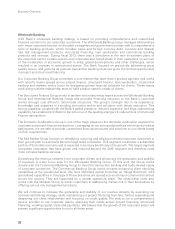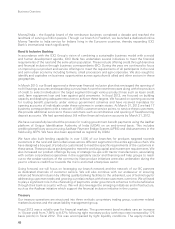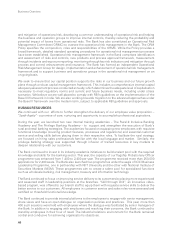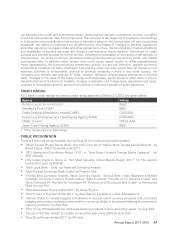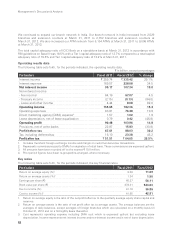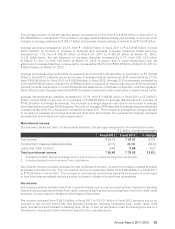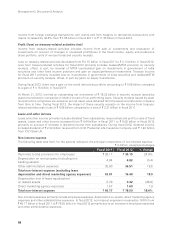ICICI Bank 2012 Annual Report Download - page 50
Download and view the complete annual report
Please find page 50 of the 2012 ICICI Bank annual report below. You can navigate through the pages in the report by either clicking on the pages listed below, or by using the keyword search tool below to find specific information within the annual report.
48
Management’s Discussion & Analysis
BUSINESS ENVIRONMENT
Fiscal 2012 was a challenging year for the global economy. Prolonged uncertainty around the resolution of
the Eurozone sovereign debt crisis, rating downgrades of sovereigns and slow recovery of the US economy
increased risks to global growth.
The Indian economy saw moderation in economic activity during fiscal 2012, following domestic
macroeconomic conditions of high interest rates and slowdown in investments. India’s gross domestic
product (GDP) grew by 6.9% during the first nine months of fiscal 2012, compared to a growth of 8.1% in
the corresponding period of fiscal 2011. During this period, the industrial sector grew by 3.3% compared
to 7.0% in the corresponding period of the previous year. The services sector grew by 8.8%, similar to the
growth in the previous year, while the agriculture sector grew by 3.2% compared to 6.8%. Investments,
as measured by gross fixed capital formation, declined by 0.2% during the first nine months of fiscal 2012
compared to a growth of 8.9% in the corresponding period of fiscal 2011. Private consumption growth also
moderated to 5.1% during the first nine months of fiscal 2012 compared to 8.5% in the corresponding
period of fiscal 2011. The Index of Industrial Production (IIP) recorded a growth of 3.5% year-on-year (y-o-y)
during the first eleven months of fiscal 2012 compared to 8.1% increase in the corresponding period of
fiscal 2011. During this period, production in the mining sector declined by 2.1%, while the manufacturing
sector recorded a growth of 3.7% and electricity sector of 8.7%, as compared to growth of 5.8%, 8.7% and
5.3% respectively in the first eleven months of fiscal 2011. The Central Statistical Organisation has estimated
GDP growth for fiscal 2012 at 6.9%, compared to 8.4% in fiscal 2011.
Inflation, measured by the Wholesale Price Index (WPI), remained above 9.0% levels between April-
November 2011 but moderated from thereon to end the year at 6.9% in March 2012. Average inflation for
fiscal 2012 was 8.8% as compared to 9.5% in fiscal 2011. The decrease was largely driven by falling inflation
in food articles, which declined from 15.8% in fiscal 2011 to 7.4% in fiscal 2012. Manufactured products
inflation initially went up to above 8.0% levels till November 2011, but moderated to 4.9% by March 2012.
Core inflation (defined as manufactured products excluding food products) reduced from 8.5% in March
2011 to 4.7% in March 2012.
Reserve Bank of India (RBI) calibrated its policy stance in line with macroeconomic conditions. During
fiscal 2012, the repo rate was increased by 175 basis points from 6.75% to 8.50%, with the last increase
of 25 basis points effective from October 25, 2011. Based on the moderation in economic growth and the
inflation trajectory, RBI in its mid-quarter monetary policy review in December 2011 paused further tightening
of policy rates. In the third quarter monetary policy review announced in January 2012, RBI reduced the cash
reserve ratio (CRR) by 50 basis points from 6.0% to 5.50%. CRR was further reduced by 75 basis points in
March 2012 to 4.75%. In its annual policy review for fiscal 2013 announced in April 2012, RBI reduced the
repo rate by 50 basis points to 8.00%. During fiscal 2012, in an attempt to improve monetary transmission in
the system, RBI established the repo rate as the single independent policy rate with the reverse repo pegged
at a fixed 100 basis points below the repo rate. Also, a new Marginal Standing Facility was introduced under
which banks could borrow overnight up to one per cent of their net demand and time liabilities, at 100 basis
points above the repo rate.
Liquidity in the system continued to remain in deficit through fiscal 2012. Compared to an average
borrowing by banks under the liquidity adjustment facility (LAF) window of RBI of ` 470.82 billion in
fiscal 2011, average borrowing increased to ` 798.78 billion in fiscal 2012. The liquidity deficit crossed
` 1.00 trillion from November 2011. The average daily borrowing touched a peak of ` 1.96 trillion in
end-March 2012. In view of the tight liquidity conditions, apart from the reduction in CRR, RBI also injected
liquidity through open market operations aggregating around ` 1.30 trillion between November 2011 and
March 2012. The yields on the benchmark 10 year government securities increased by about 58 basis points


